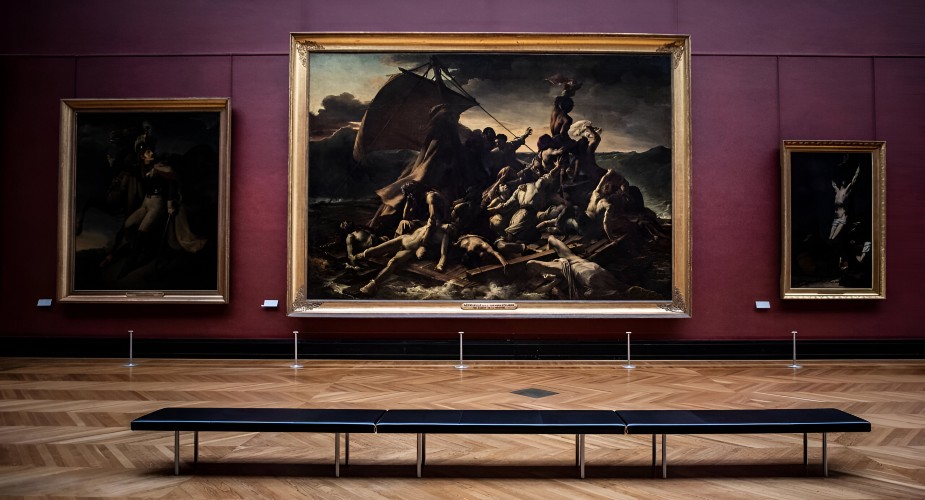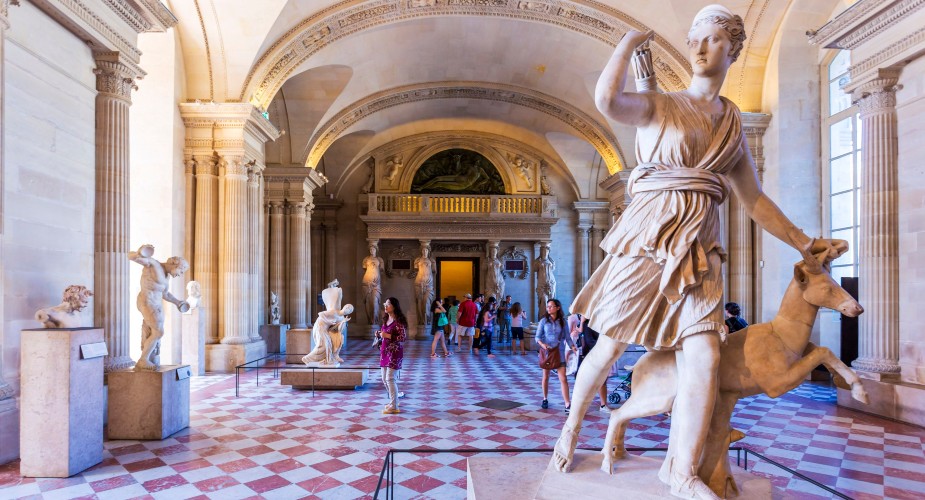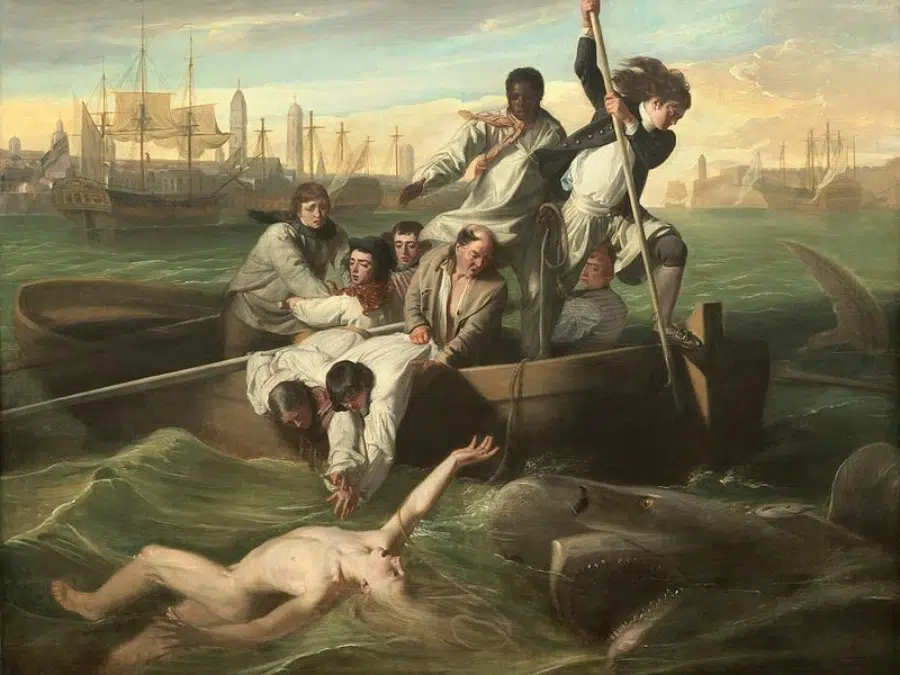Theodore Gericault’s Raft of the Medusa is one of the most tragic art pieces on display in the Louvre, depicting the scene of the wreckage of the French Frigate. It is a portrayal of suffering, desperation, and hope, all on one canvas, and is a must-see for all history and art lovers for its terrifying beauty! Visitors planning to explore the Museum with the Raft of the Medusa painting on their itinerary must know all about its backstory, location, and history. In this article, we’ll discover the tragic painting in detail and discover its controversies and painting techniques! Also, find great ticket options to explore the space.
Description of the Painting
Because of this painting’s monumental size, most figures are life-sized, making the scene much more emotional. The figures in the front of the piece are double the size, making the viewer feel like he is a part of the piece and is sailing toward the raft. The facial expressions of all the figures at the center of the raft suggest despair and emptiness. Some men point out far away, indicating that they see a ship and wave of white and red clothes, hoping to be rescued! On the left, a man holds the corpse of his son to prevent it from floating away at sea.
Theodore follows a double-pyramid composition, with the sail as one peak of the pyramid and people climbing over each other as the other peak. At the base is a small plank of wood used as a raft, surrounded by bodies of the fallen hanging off the plank in the water. At the top of the pyramid structure on the right is a man waving a red cloth, whose pose is completely inspired by the Belvedere Torso! Géricault uses muted and dark shades of color to depict sorrow and enhance the emotions of all the figures on the raft. Every part of this painting tells a story and is a must-see attraction for all visitors!
The Raft of the Medusa Story
The tragic accident in the painting began after June 1816, when the French frigate Medusa sailed to sea with Hugues Duroy de Chaumareys. The ship was sailing towards the port of Saint Louis with a mission to take back Senegal as per the Paris Treaty from under the British. The Medusa began overtaking the other ships to reach on time, but because of poor navigation on the captain’s part, it drifted off course by 160 km. This was when it crashed into a sandbag off the Mauritius coast on 2nd July 1816, with 400 passengers on board. The crew tried to free the ship but failed, so on July 5th, passengers hopped onto six boats in hopes of reaching the shore.
There was space only for 250 passengers onboard, so the other 146 men and women chose rafts made of wooden planks to escape on. This depiction shows the crew and other passengers who hopped on a makeshift raft and left only with two packets of biscuits, six casks of wine, and two bottles of drinking water. These survivors were stuck on the raft for 13 days and began killing each other for food. The crew was rescued by the Argus on July 17, 1816, and the incident caused great shame to the French monarchy.
Where is it on display in the Louvre?

The Raft of the Medusa is on display in the Denon Wing, which is one of the most crowded wings of the Louvre. It is displayed in Room 700 of the Red Rooms, also known as the Salle Mollien, on the Wing’s first floor. The room has red walls and wooden flooring, and the walls are lined with massive paintings, all in gold-colored frames. The red color of the walls makes the Raft of the Medusa painting appear more haunting!
You can also see the revolutionary Liberty Leading the People painting by Eugene Delacroix in Room 700! Another must-see painting on display close by is the Coronation of Napoleon by Jacques-Louis David in Room 702 on the same floor.
Best Time to Visit the Denon Wing

Since the Denon Wing is the most crowded, we recommend exploring between 9 am and 10 am, and from 3 pm to 5 pm on weekdays. On weekends, it is best to explore in the morning from 9 am to 10 am. The wing is open for exploration from 9 am to 6 pm on Mondays, Thursdays, and weekends, and from 9 am to 8 pm on Wednesdays and Fridays. The Louvre is closed on Tuesdays. We don’t recommend exploring the Denon Wing on the first Friday of the month after 6 pm since admission is free on this day, which attracts massive crowds. You can take the Ports des Lions Entrance to the Denon Wing directly.
Louvre Museum secrets? You’re invited in!
Join millions of happy travelers by booking with our world-trusted partners.
Louvre Museum Tickets to see Gericault’s Masterpiece
You must have Louvre Musuem tickets to explore all the wings of the Museum and see the Medusa Raft painting. The standard Louvre skip-the-line tickets are perfect for exploring the Denon Wing and other parts of the Museum till closing hours, costing €25 for visitors 18 to 99 years old.
History and art lovers can ask more questions about the dreadful backstory and techniques of Raft of the Medusa painting on a 2-hour Guided Tour. It costs €84 for visitors 18 to 99, and children under 18 can enjoy a discounted entry of €69!
Gericault’s Painting Techniques
Theodore Gericault saw great potential to become famous with this piece of art, so he dedicated much of his time to perfecting his techniques and experimenting to paint it. The scene appears almost 3D to all visitors since Gericault painted the people overlapping each other. The main focus of this painting is the raft at the center, so the rescue ship is kept as a background accessory to show the despair of the people as it sails away.
The Raft of the Medusa is a romantic painting focusing on the suffering of all the figures lost at sea, so he uses the Chiaroscuro painting technique. The Chiaroscuro and Tenebrism techniques use light and dark shading elements to show their grief and define the darkness of the scene. Caravaggio’s paintings inspired Theodore to use these light and dark shadow techniques! He also drew inspiration from Michelangelo’s Last Judgement fresco and Copley Watson and the Shark by John Singelton.
History & Controversies about the painting

The curator, Comte de Forben, brought the Raft of the Medusa to the Louvre in 1824 after Theodore Gericault’s death. It was on display at the Paras Salon in 1819 for a while before it came to the Louvre. There were not many controversies about the painting since people were mainly still focused on and shocked by the actual accident when it was completed.
However, the French critics were not pleased with the gruesome, realistic depictions shown in the piece. They also criticized the political implications of the painting. King Louis XVIII threatened Gericault regarding the painting as it displayed the failure of the French Empire. The presence of an African American man with dark skin also forced people to think about their ideas of slavery in the past.
Fun Facts about the Raft of the Medusa Painting
Want to know more? Here are some fun facts about the painting, so you can show off your knowledge to your friends and family!
- Eugene Delacroix’s portrait is in the painting! You cannot see his face as he is depicted lying down on his stomach on the raft, holding on to a wooden plank.
- Géricault worked with the actual survivors to paint this masterpiece.
- He chose this scene among the other scenes of rebellion against the officers, cannibalism on the raft, and a rescue scene. You can also see Theodore’s painting of Cannibalism on the Raft of Medusa in the Louvre.
- Theodore took references from the faces of his friends and family members to paint the survivors on the raft.
FAQs on The Raft of the Medusa
1. What is the story of the Raft of Medusa?
The painting depicts the story of the accident of the French Frigate Medusa, which crashed. It left 15 survivors stranded out on the seas for 13 days who were starving and desperate to be saved.
2. What does Gericault’s painting symbolize?
Gericault’s painting shows the true rawness of fear and desperation when humans are at their worst. It also speaks against the French monarchy and highlights the extent of their failure.
3. What was Raft of the Medusa controversial?
The painting was controversial as it displayed the failure of the French Monarchy. Because of this, Theodore Gericault also received threats from King Louis XVIII.
4. Where is the Raft of Medusa located?
The painting is in the Denon Wing on the first floor in Salle Mollien, room number 700, also called the red rooms.
5. What is the ticket price to see the Denon Wing?
The standard entry ticket, with skip-the-line access, and a one-day validity period costs €25 for visitors 18 to 99 years old.
6. What is the best time to see Raft of Medusa painting?
The Denon Wing is the least crowded from 9 am to 10 am and 3 pm to 5 pm on weekdays. On weekends, it is less crowded from 9 am to 10 am.
7. What painting technique was used in Medusa’s Raft by Gericault?
The main painting technique used in the painting is Chiaroscuro, which uses light and dark shades to provide depth and emotion to all features. He also added a double pyramid composition for the painting.




